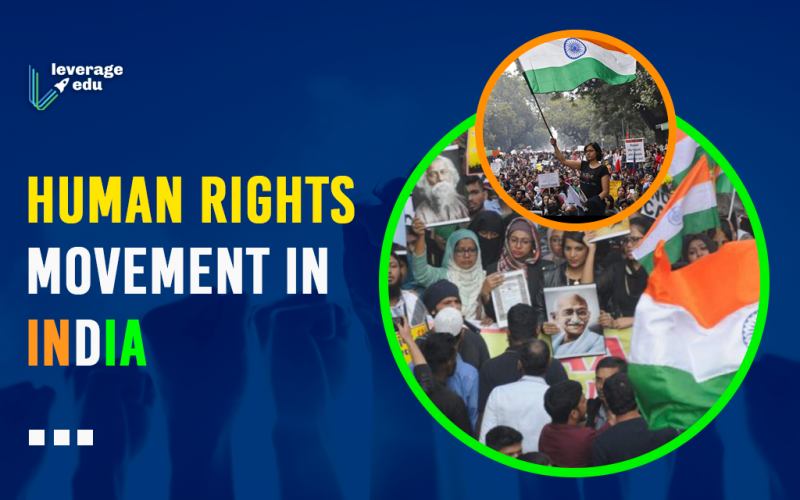Every country, culture, and ethnicity has one thing in common, irrespective of where they come from, everyone in the world holds certain rights as a human being. These are the rights that we have as human beings; they are not granted by any state. Human rights are inherent to everyone but every now and then, communities get together to fight for a right that is rightfully theirs. Even in India, there have been many stories that sing the saga of human rights and their implementation. While some happened in the vicinity of a house, some created an impact so large that Indians now get to reap its benefit today. Let us know about some of these human rights movements in India that changed the course of life:
This Blog Includes:
Human Rights in Ancient India
The trace of the concept of human rights can be paved back to the Vedas period of the 15 Century B.C. In Vedas, human rights are signified with the concept of equality. The Charter of equality of all is defined in the Vedas with the following words- ‘No one is superior or inferior, all should strive for the interest of all and should progress collectively’.
Kautilya summed up the concept of the welfare state by saying that the happiness of the state lies in the happiness of its subjects. During the period, civil and legal rights were first formulated by Manu that included a number of economic rights. The importance of human rights was well supported by Jainism, Buddhism and other minority religious groups. King Ashoka worked day and night for the protection of human rights.
Also Read: Kalinga War: Cause, Effect, Year, Result
After the Emergency
The emergency was put by the government of India in 1975. Hundreds of thousands of people joined massive rallies to protest against the anti-democratic acts of the government and to mobilize public opinion to safeguard Indian democracy.
Organizations such as Citizens for Democracy, People’s Union for Civil Liberties (PUCL), People’s Union for Civil Liberties and Democratic Rights (PUCLDR), and Chhatra Yuva Sangharsh Vahini were at the forefront of human rights struggles at the national level.
Dozens of state-level and city-based groups were also formed during this period. For example, the Committee for Protection for Democratic Rights (Mumbai), Association for Protection of Democratic Rights (APDR), and Andhra Pradesh Civil Liberties Committee (APCLC) in Hyderabad.
During the 1980s, those who were concerned only about formal democracy confined themselves to the ‘civil liberties movement’. Organizations working against the repression of workers, poor, peasants, Dalits, women, and tribal people joined the ‘democratic rights movement’. This set the tone for human rights movements in India during the 1990s that established their networks from local and regional to a global level.
Now, we have reached a stage where social movements of all ideological hues accept the ‘emancipatory potential’ of human rights. Even the mainstream institutions—universities, print and electronic media, religious organizations, and political parties—with mutually exclusive interests talk about ‘violation of human rights in their campaigns.
Also Read: Human Rights Courses [Exciting Career Paths]
Women in Human Rights Movements in India
Nationwide anti-rape campaign in 1980 resulted in the emergence and proliferation of autonomous women’s organizations in several cities and towns of India. They did agitation and propaganda work against series of rape cases in a custodial situation, domestic violence, and dowry harassment. The groups soon realized that to work on a sustained basis for rehabilitative aspects of violence against women, it was important to evolve institutional structures for support to the women victims of violence based on feminist principles of solidarity (mutual counseling) and sisterhood.
Initially, they concentrated on women-specific issues such as wife battering and dowry murders, domestic violence, rape and eve-teasing, honor killing, pornographic films, plays, and literature on harassment of women at the workplace. Militant actions, social boycott, gherao of tormentors, raiding of the matrimonial homes for retrieval of dowry had to be resorted to because of antipathy/lethargy of the state apparatus. From these experiences of direct action, the activists of the women’s groups learned the power relations operating within modern families (working class, middle class, and upper class), different religious communities, and various caste organizations.
Dalit Movements
Human rights violations of vulnerable groups in contemporary India are a result of complex nexus between the politics of identity, exclusion, inclusion, and segregation, rooted in history, cultural ethos, politics, and economics
Beginning in the 1920s, various social, religious, and political movements rose in India against the caste system and in support of the human rights of the Dalit community. In 1950, the Constitution of India was adopted, and largely due to the influence of Dr. B.R. Ambedkar (chairman of the Constitutional Drafting Committee), departed from the norms and traditions of the caste system in favor of justice, equality, liberty, and fraternity, guaranteeing all citizens basic human rights regardless of caste, creed, gender or ethnicity. The implementation and enforcement of these principles have, unfortunately, been an abysmal failure. Despite the fact that ‘untouchability’ was abolished under India’s constitution in 1950, the practice of ‘untouchability’—the imposition of social disabilities on persons by reason of their birth in certain castes—remains very much a part of India.
These movements inspire us to speak about the injustice that happens. For more content like this, make sure you follow Leverage Edu on Facebook, Instagram, and LinkedIn. Do let us in the comments down below what you think about the different movements that have taken place.

 One app for all your study abroad needs
One app for all your study abroad needs





















 45,000+ students trusted us with their dreams. Take the first step today!
45,000+ students trusted us with their dreams. Take the first step today!


